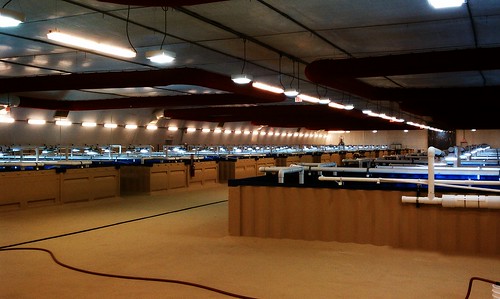While out in Vegas to give a few talks to restaurant staff, I had the chance to visit a shrimp farm. I’m not one to turn down an aquaculture opportunity, let alone such a thing happening in the desert.
The facility, Blue Oasis Pure Shrimp, is a pretty neat place. The tent-like white building shimmering in the 100-degree heat was no mirage. Although I’m told the materials for the building fit on three large trucks.
 Inside, one sees row after row of vessels filled with shrimp at various stages of life (from Sea Monkey to shrimp cocktail size). The beige bins are old shipping containers cut in half.
Inside, one sees row after row of vessels filled with shrimp at various stages of life (from Sea Monkey to shrimp cocktail size). The beige bins are old shipping containers cut in half.
While visiting the facility with some restaurateurs interested in the product, I had a chance to learn about lost product. Our guide, Blue Oasis chief Adrian Zettell, said that loss at a covered facility using fresh shrimp was virtually nonexistent.
Yet, Zettell estimated that in traditional shrimp-farming operations overseas, the attrition rate is about 40%. Most of the loss comes from lack of roof coverage—birds swooping in to hunt the ‘shrimp in a barrel’ or letting loose over the tanks, contaminating the water.
Meanwhile, catching wild shrimp also comes at a cost. There’s that whole bycatch thing. And that the vast majority of wild-caught shrimp come frozen leads to another problem. Zettell estimated that sorting frozen shrimp causes about 20% loss because they’re brittle and crack.
That level of waste is even more striking when one considers the mammoth Vegas demand of 60,000 pounds of shrimp per day! That not-so-shrimpy amount is said to equal that of the rest of the country combined!